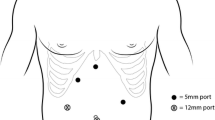Abstract
Background: Thirty-three patients were candidates for laparoscopic choledochotomy. The indications for this operation are described.
Methods: The procedure was completed 32 times (97%). We had 29 successful common bile duct (CBD) clearances, three negative explorations, and one failed clearance which needed to be converted to laparotomy. All the completed procedures ended with primary closure of the main duct. Median duration of surgery was 180 min (range 100–300), including three associated laparoscopic procedures.
Results: There were three postoperative complications (9.4%), none major. Average postoperative hospital stay was 7.1 days (range 4–14). In May–June 1995 we controlled 31 out of the 32 consecutive patients (one patient was lost to follow-up) who had a successful laparoscopic choledochotomy from October 1991 to December 1994. Median follow-up was 22 months (range 5–44). Besides clinical control, 23 patients also had ultrasound (US) controls and 24 had blood tests. Eleven had intravenous cholangiotomography. Two patients died 11 and 22 months after the operation for unrelated causes and without biliary symptoms. Two patients had umbilical hernias. One had a small residual asymptomatic stone, which was removed endoscopically. None had signs of postoperative CBD stricture. At US, CBD was ≤7 mm in 15 patients, 8–10 mm in four patients, and 10–12 mm in three patients. The last group had preoperative CBD dilation, too. We could compare preoperative and postoperative CBD diameters in 22 patients: 11 had no change; in nine it decreased; and two had a slight increase (8–10 mm).
Conclusions: We conclude that laparoscopic choledochotomy with primary closure is a very good operation: It has a high success rate and low morbidity. Mortality is nil so far. Medium-term results are very positive: We had no CBD stricture and only one case of asymptomatic residual stone, which could have been avoided. Our results suggest that intraductal biliary drainage is useless, and its specific complications are well known.
Similar content being viewed by others
Author information
Authors and Affiliations
Additional information
Received: 20 October 1995/Accepted: 28 February 1996
Rights and permissions
About this article
Cite this article
Croce, E., Golia, M., Azzola, M. et al. Laparoscopic choledochotomy with primary closure . Surg Endosc 10, 1064–1068 (1996). https://doi.org/10.1007/s004649900241
Published:
Issue Date:
DOI: https://doi.org/10.1007/s004649900241




